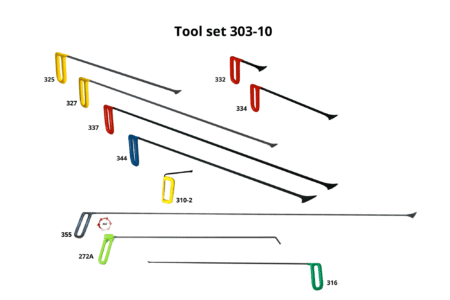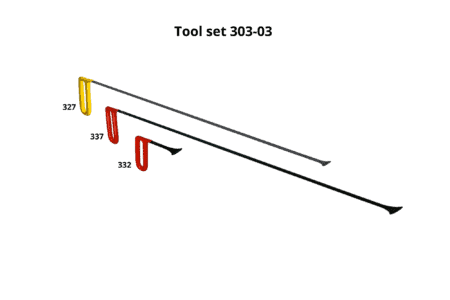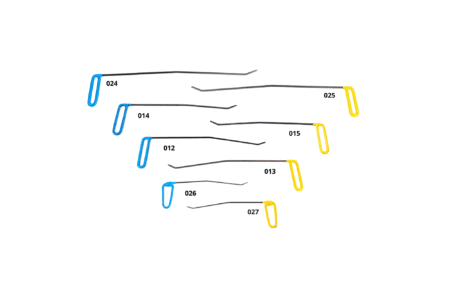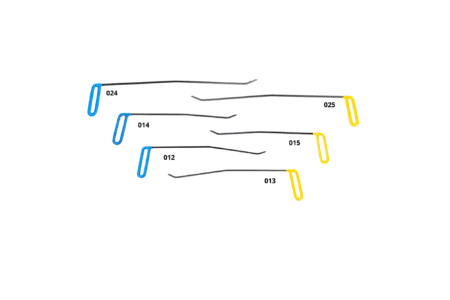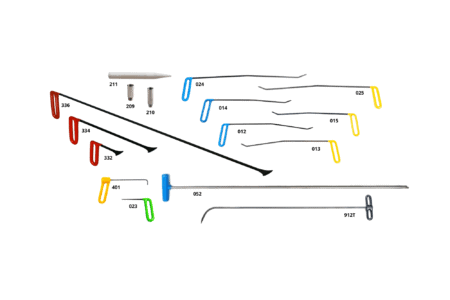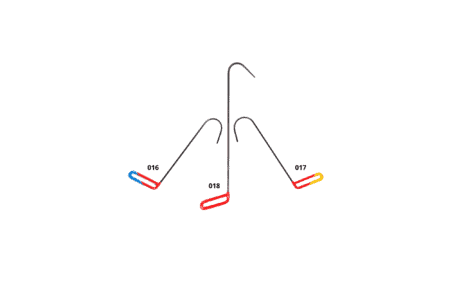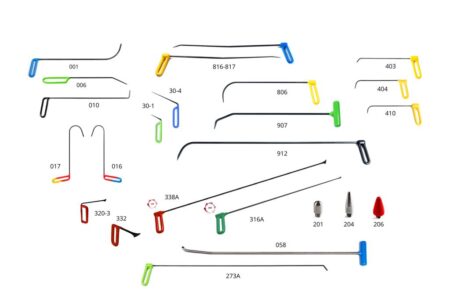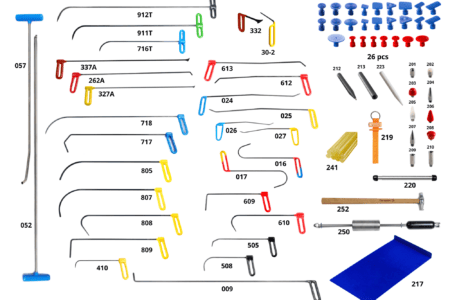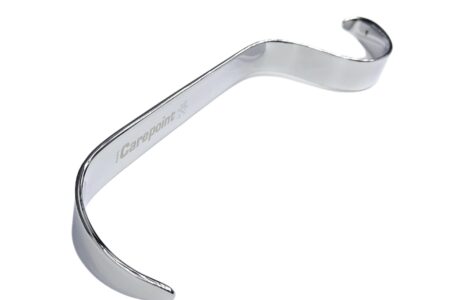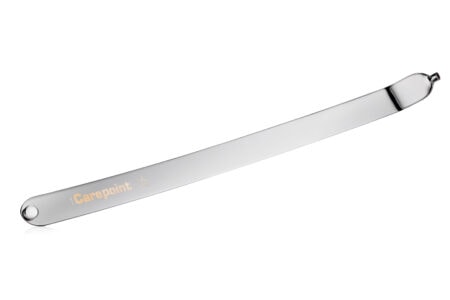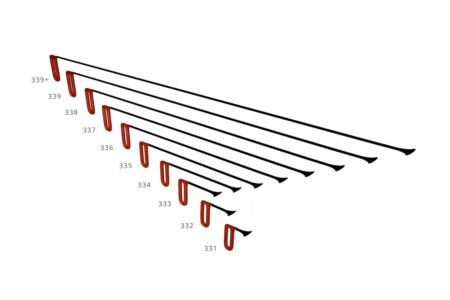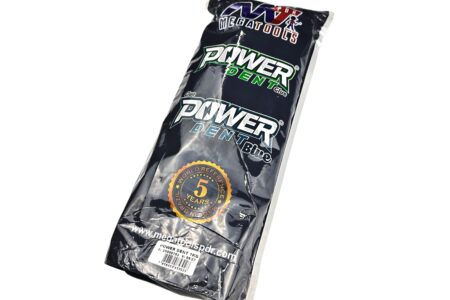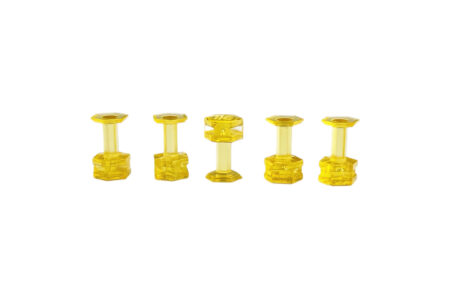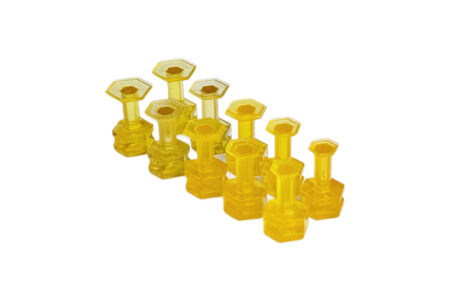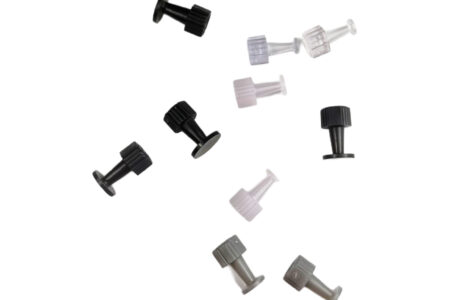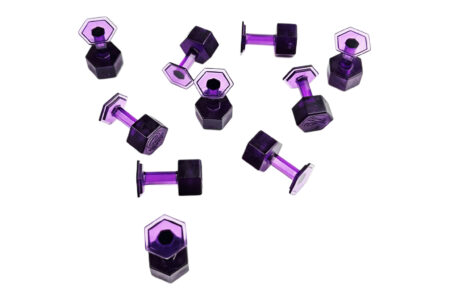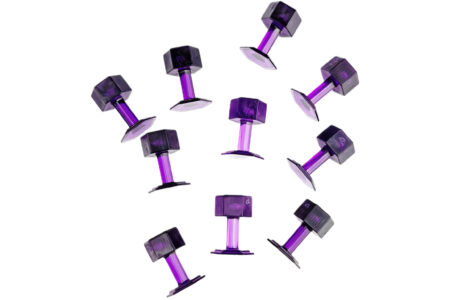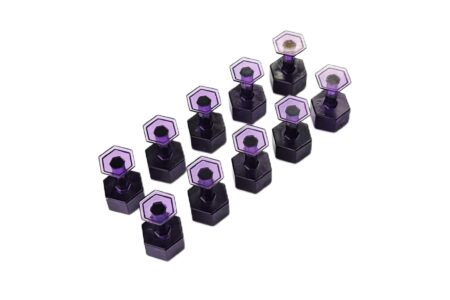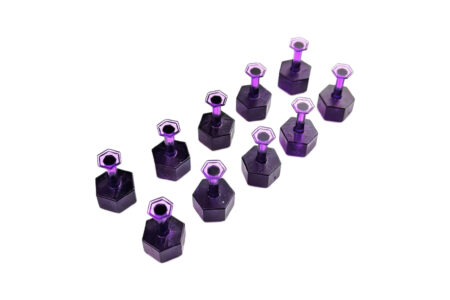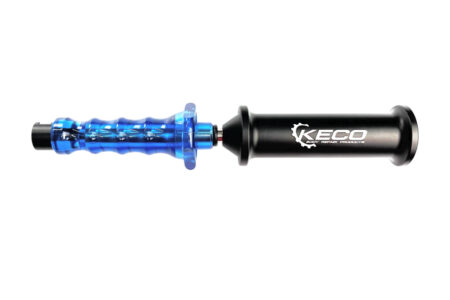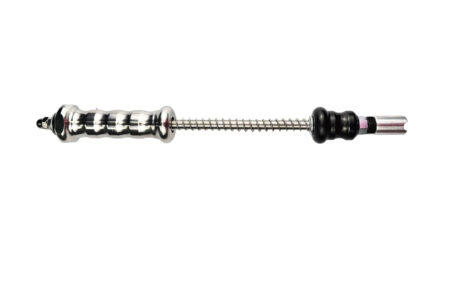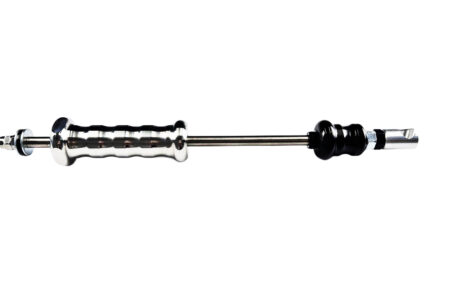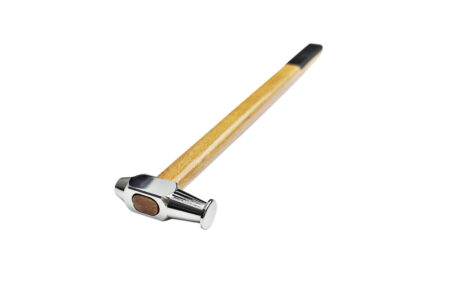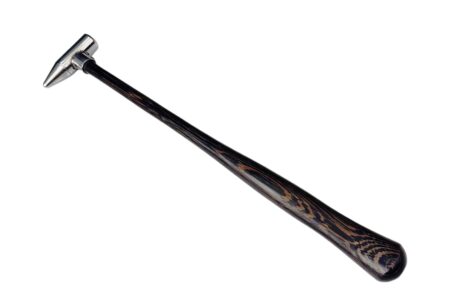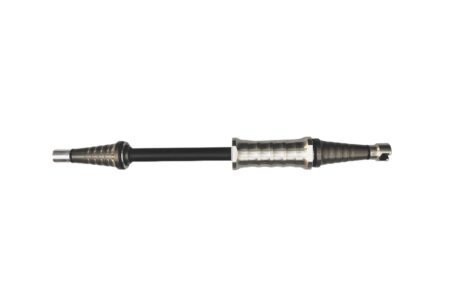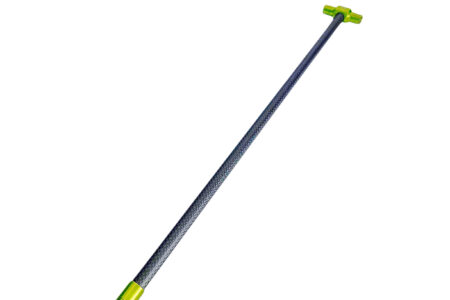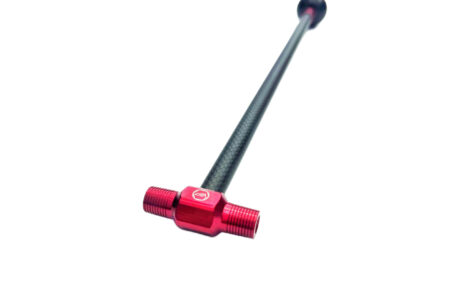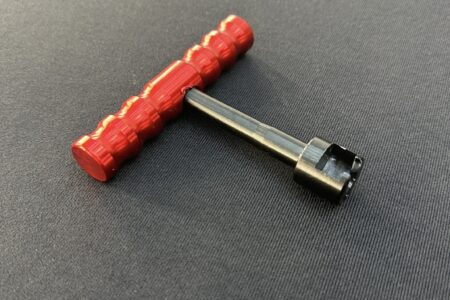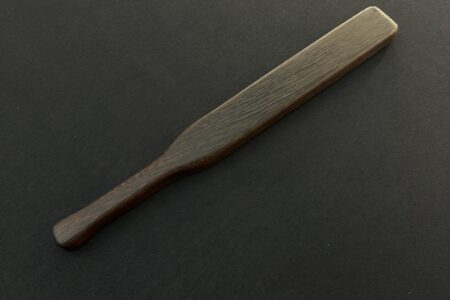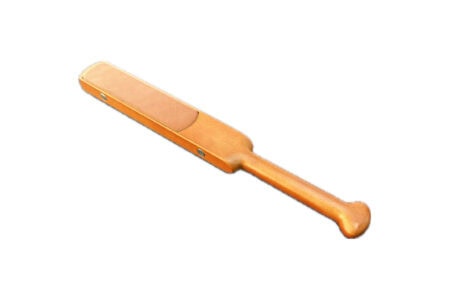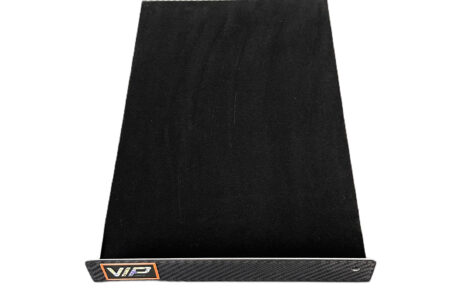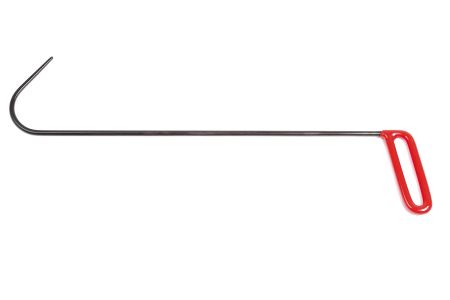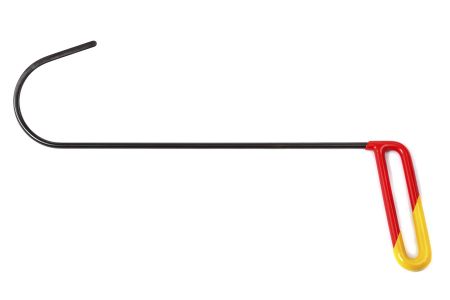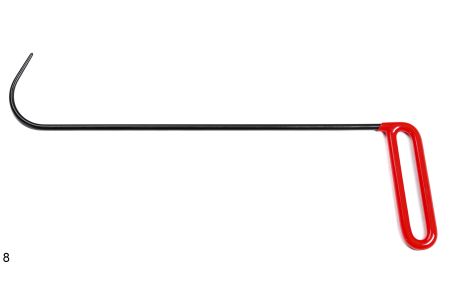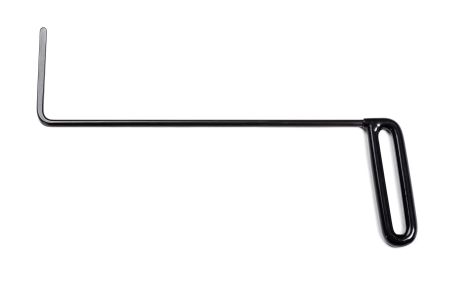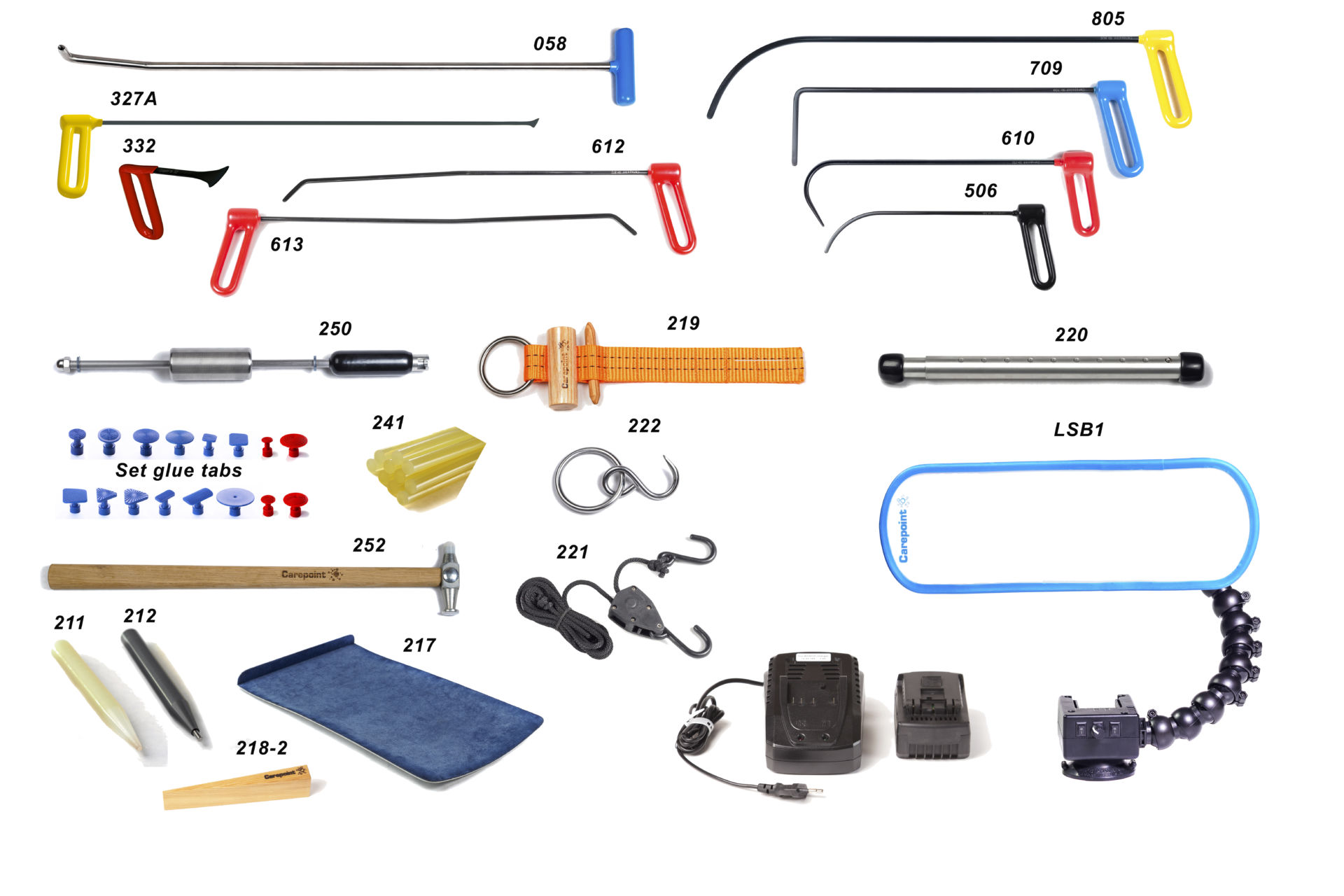
What PDR tools are needed for bodywork?
Car repair is a complex procedure that requires a professional approach and the use of specialized tools. Most often, car owners are faced with body defects: dents or scratches caused by bumps or bad weather conditions. Such damage spoils the appearance of the car and reduces its value.
Traditional body repair methods can be expensive and time-consuming. That’s why a faster and cheaper option: Paintless Dent Repair (PDR) — is best for minor damage. This method allows you to repair dents while preserving the vehicle’s factory paintwork. It reduces the repair time and avoids the need for paint.
In this article, we’ll look at the basic PDR tools you’ll need for repairs, from simple fixtures to complex mechanisms that help you restore your car bodywork with minimal time and money.
What is Paintless Dent Removal
Paintless Dent Removal (PDR) is the repair of car bodywork from dents, creases and other damage without the use of paint. This method of restoration helps to quickly and cost-effectively remove irregularities and restore the appearance of the car.
To do their work, specialists use PDR tools: they use them to “push” the dents from the inside, to remove the imperfections and to smooth out the bodywork. This method is effective for minor damage and helps to restore the car faster and cheaper than traditional repairs. PDR also helps to preserve the car’s factory paintwork, which is important for maintaining its value and appearance.
Repairers most often order ready-to-use PDR tool sets. They are ideal for the job because they contain everything you need for effective dent removal. They allow you to start the repair quickly without wasting time selecting individual tools.
How Paintless Dent Repair works in simple terms
PDR is an effective way to remove dents without having to repaint the car. It allows you to preserve your car’s factory paint, which is important for its value and appearance.
The basic idea behind PDR is to push the dent out of the bodywork from the inside, restoring it to its original condition. To do this, specialists use a variety of methods and tools, including working both inside and outside the car body.
PDR dent repair can be done in two ways:
From the inside. The master uses special tools to press the dent from the inside, pushing it outwards.
From the outside using a tab system. A special tabis attached to the area of the dent and then pulled, pulling the dent out.
Usually, masters prefer the first method, and the second method is used where it is difficult to reach with conventional tools. In this case, the repair can take from 10 minutes to 1.5 hours. After the repair, the original paintwork and intact parts are retained, reducing time and cost, making the repair more affordable.
Advantages of Paintless Dent Removal
Dent removal using PDR tools has some significant advantages over other repair methods. It is more cost effective than traditional repairs and typically takes less time than puttying or replacing panels. In addition, PDR preserves the car’s original paintwork, which is particularly important when restoring retro cars. We’ll look at each of these points in more detail in the following sections.
More economical and efficient
Repair costs depend on the number and size of the defects. The cost is also affected by the availability and location of the dents – fenders, struts, hood, roof. In any case, this method does not require huge financial expenses. In very rare cases, the cost of a PDR repair can be equal to or more expensive than a traditional repair.
If it is possible to keep the original part, it is better to repair it without repainting. This will make the car more competitive on the market when it is sold, compared to cars where parts have been repainted or replaced with new ones.
Faster than traditional repairs
Repairing a damaged part of the car without paint often requires little or no disassembly of the bodywork. The use of high quality professional tools allows repairs to be carried out in hard-to-reach areas.
PDR repairs can take much less time than the traditional method of repairing a damaged part. Depending on the complexity of the damage, a PDR repair can take anywhere from 5 minutes to 8 hours to complete. Painting a single part typically takes 1 to 2 days.
Preserving your car’s original paintwork
When it comes to repainting damaged areas of your car, you need to be aware that there are a number of serious risks and potential problems involved. Even with the most thorough paint job, there is a risk of colour mismatch or other imperfections in the factory finish. And here’s why:
Color matching. When painting parts, there are often difficulties in selecting the exact shade of paint. Many masters prefer to use the “spray” method which avoids some problems but does not guarantee a complete color match.
Lacquer shimmer. Each car has a unique varnish shimmer, which is difficult to reproduce exactly. This can lead to noticeable differences in shade between the repainted part and the rest of the bodywork.
Paint layer thickness. Repainted areas often have a thicker layer of paint, which can be a tell-tale sign of a repair. Used cars with these signs may be questionable for future owners.
Suitable for restoration of retro cars
The use of PDR technology is the most gentle method of restoring the bodywork of retro cars. This is especially important as much depends on the specific situation and the condition of the factory paintwork. If the paint and varnish are free of cracks and sharp dents, it is possible to preserve the factory coating when using PDR tools. This method allows repairs to be carried out while minimizing interference with the original condition of the car, which is especially important for retro models, preserving their historical and collectible value.
What dents can be repaired with PDR?
Dents that can be repaired with PDR are usually simple damage that does not require conventional body paint. They are usually extensive but shallow and can be caused by a ball, a foot, heavy pressure on the surface of the vehicle or hail.
However, scratches, deep and pitting dents on edges, dents on stamped elements as well as dents on highly curved and thick-walled body parts require a more specialized approach and can only be repaired using the PDR method.
It is important that dent repair is carried out as soon as possible after the damage has occurred, provided the paintwork remains intact. Suitable tools should be selected depending on the nature of the damage and the repair method used.
Glue method of paintless dent removal
This is one of the most popular methods of removing damage on the bodywork and many people find it very easy. However, in order to get rid of the dent completely, you need to have a lot of experience with this method.
A suction mushroom is glued over the dent. Then a special tool — a mini lifter — is placed over the dent, which holds the suction cup in place and gradually levels out the dent.
Dent removal with Fixed Handle Rods
Another effective method of dent removal is the use of special fixed handle rods. These tools are inserted through technological holes in the body and are used to press out dents from the inside of the part. Importantly, the repair is carried out from the inside, so the tools are invisible from the outside. For more precise control and targeting, special lamps are often used to allow masters to see the dent and the tool as they work.
The advantage of this method is its versatility. Handle rods can be used to remove different types of dents, from small damage to larger defects. This versatility allows the bodyshop technician to complete a variety of tasks effectively and with a high quality result.
Our range includes a variety of handle rod types to suit different types of dents and repair complexity.
From standard models suitable for beginners to professional options designed for experienced masters, we offer a wide range of tools to meet any car body repair need.
-
FIXED HANDLE RODS, Hail (Roof) Tip Rods
PDR Hail rod for interchangeable tips ⌀–14 mm/0,55″, L-950mm/37,4″ Carepoint 060
FIXED HANDLE RODS, Hail (Roof) Tip RodsPDR Hail rod for interchangeable tips ⌀–14 mm/0,55″, L-950mm/37,4″ Carepoint 060
0 out of 5(0)Paintless Dent Repair Hail rod for interchangeable tips 060
SKU: 060 -
Fender Tools, FLATBAR, INNOVATION 2024
Flat Bar Black High Carbon Steel L–670mm/26″, Width–40mm/1,6″ Carepoint 290B
Fender Tools, FLATBAR, INNOVATION 2024Flat Bar Black High Carbon Steel L–670mm/26″, Width–40mm/1,6″ Carepoint 290B
0 out of 5(0)Paintless Dent Repair Flat Rod, Black High Carbon Steel Carepoint 290B
Attention! The tip of the has changed, look at the last photo
SKU: 290B -
2.0inch / 50mm Whale Tails, FIXED HANDLE RODS, PDR TOOL SETS, Whale Tails rod with fixed handle
Carepoint PDR Tool Set «2 inc 50 ММ WHALE TAIL BLACK»
2.0inch / 50mm Whale Tails, FIXED HANDLE RODS, PDR TOOL SETS, Whale Tails rod with fixed handleCarepoint PDR Tool Set «2 inc 50 ММ WHALE TAIL BLACK»
0 out of 5(0)SKU: n/a -
1.6inch / 40mm Whale Tails, FIXED HANDLE RODS, PDR TOOL SETS, Whale Tails rod with fixed handle
Carepoint PDR Tool Set «1.6 inc 40 ММ WHALE TAIL BLUE»
1.6inch / 40mm Whale Tails, FIXED HANDLE RODS, PDR TOOL SETS, Whale Tails rod with fixed handleCarepoint PDR Tool Set «1.6 inc 40 ММ WHALE TAIL BLUE»
0 out of 5(0)SKU: n/a -
1.2inch / 30mm Whale Tails, FIXED HANDLE RODS, PDR TOOL SETS, Whale Tails rod with fixed handle
Carepoint PDR Tool Set «1.2 inch 30 ММ WHALE TAIL RED»
1.2inch / 30mm Whale Tails, FIXED HANDLE RODS, PDR TOOL SETS, Whale Tails rod with fixed handleCarepoint PDR Tool Set «1.2 inch 30 ММ WHALE TAIL RED»
0 out of 5(0)SKU: n/a
How Paintless Dent Repair works in simple terms
PDR is an effective way to remove dents without having to repaint the car. It allows you to preserve your car’s factory paint, which is important for its value and appearance.
The basic idea behind PDR is to push the dent out of the bodywork from the inside, restoring it to its original condition. To do this, specialists use a variety of methods and tools, including working both inside and outside the car body.
PDR dent repair can be done in two ways:
From the inside. The master uses special tools to press the dent from the inside, pushing it outwards.
From the outside using a tab system. A special tabis attached to the area of the dent and then pulled, pulling the dent out.
Usually, masters prefer the first method, and the second method is used where it is difficult to reach with conventional tools. In this case, the repair can take from 10 minutes to 1.5 hours. After the repair, the original paintwork and intact parts are retained, reducing time and cost, making the repair more affordable.
Advantages of Paintless Dent Removal
Dent removal using PDR tools has some significant advantages over other repair methods. It is more cost effective than traditional repairs and typically takes less time than puttying or replacing panels. In addition, PDR preserves the car’s original paintwork, which is particularly important when restoring retro cars. We’ll look at each of these points in more detail in the following sections.
More economical and efficient
Repair costs depend on the number and size of the defects. The cost is also affected by the availability and location of the dents – fenders, struts, hood, roof. In any case, this method does not require huge financial expenses. In very rare cases, the cost of a PDR repair can be equal to or more expensive than a traditional repair.
If it is possible to keep the original part, it is better to repair it without repainting. This will make the car more competitive on the market when it is sold, compared to cars where parts have been repainted or replaced with new ones.
Faster than traditional repairs
Repairing a damaged part of the car without paint often requires little or no disassembly of the bodywork. The use of high quality professional tools allows repairs to be carried out in hard-to-reach areas.
PDR repairs can take much less time than the traditional method of repairing a damaged part. Depending on the complexity of the damage, a PDR repair can take anywhere from 5 minutes to 8 hours to complete. Painting a single part typically takes 1 to 2 days.
Preserving your car’s original paintwork
When it comes to repainting damaged areas of your car, you need to be aware that there are a number of serious risks and potential problems involved. Even with the most thorough paint job, there is a risk of colour mismatch or other imperfections in the factory finish. And here’s why:
Color matching. When painting parts, there are often difficulties in selecting the exact shade of paint. Many masters prefer to use the “spray” method which avoids some problems but does not guarantee a complete color match.
Lacquer shimmer. Each car has a unique varnish shimmer, which is difficult to reproduce exactly. This can lead to noticeable differences in shade between the repainted part and the rest of the bodywork.
Paint layer thickness. Repainted areas often have a thicker layer of paint, which can be a tell-tale sign of a repair. Used cars with these signs may be questionable for future owners.
Suitable for restoration of retro cars
The use of PDR technology is the most gentle method of restoring the bodywork of retro cars. This is especially important as much depends on the specific situation and the condition of the factory paintwork. If the paint and varnish are free of cracks and sharp dents, it is possible to preserve the factory coating when using PDR tools. This method allows repairs to be carried out while minimizing interference with the original condition of the car, which is especially important for retro models, preserving their historical and collectible value.
What dents can be repaired with PDR?
Dents that can be repaired with PDR are usually simple damage that does not require conventional body paint. They are usually extensive but shallow and can be caused by a ball, a foot, heavy pressure on the surface of the vehicle or hail.
However, scratches, deep and pitting dents on edges, dents on stamped elements as well as dents on highly curved and thick-walled body parts require a more specialized approach and can only be repaired using the PDR method.
It is important that dent repair is carried out as soon as possible after the damage has occurred, provided the paintwork remains intact. Suitable tools should be selected depending on the nature of the damage and the repair method used.
Glue method of paintless dent removal
This is one of the most popular methods of removing damage on the bodywork and many people find it very easy. However, in order to get rid of the dent completely, you need to have a lot of experience with this method.
A suction mushroom is glued over the dent. Then a special tool — a mini lifter — is placed over the dent, which holds the suction cup in place and gradually levels out the dent.
Dent removal with Fixed Handle Rods
Another effective method of dent removal is the use of special fixed handle rods. These tools are inserted through technological holes in the body and are used to press out dents from the inside of the part. Importantly, the repair is carried out from the inside, so the tools are invisible from the outside. For more precise control and targeting, special lamps are often used to allow masters to see the dent and the tool as they work.
The advantage of this method is its versatility. Handle rods can be used to remove different types of dents, from small damage to larger defects. This versatility allows the bodyshop technician to complete a variety of tasks effectively and with a high quality result.
Our range includes a variety of handle rod types to suit different types of dents and repair complexity.
From standard models suitable for beginners to professional options designed for experienced masters, we offer a wide range of tools to meet any car body repair need.
How Paintless Dent Repair works in simple terms
PDR is an effective way to remove dents without having to repaint the car. It allows you to preserve your car’s factory paint, which is important for its value and appearance.
The basic idea behind PDR is to push the dent out of the bodywork from the inside, restoring it to its original condition. To do this, specialists use a variety of methods and tools, including working both inside and outside the car body.
PDR dent repair can be done in two ways:
From the inside. The master uses special tools to press the dent from the inside, pushing it outwards.
From the outside using a tab system. A special tabis attached to the area of the dent and then pulled, pulling the dent out.
Usually, masters prefer the first method, and the second method is used where it is difficult to reach with conventional tools. In this case, the repair can take from 10 minutes to 1.5 hours. After the repair, the original paintwork and intact parts are retained, reducing time and cost, making the repair more affordable.
Advantages of Paintless Dent Removal
Dent removal using PDR tools has some significant advantages over other repair methods. It is more cost effective than traditional repairs and typically takes less time than puttying or replacing panels. In addition, PDR preserves the car’s original paintwork, which is particularly important when restoring retro cars. We’ll look at each of these points in more detail in the following sections.
More economical and efficient
Repair costs depend on the number and size of the defects. The cost is also affected by the availability and location of the dents – fenders, struts, hood, roof. In any case, this method does not require huge financial expenses. In very rare cases, the cost of a PDR repair can be equal to or more expensive than a traditional repair.
If it is possible to keep the original part, it is better to repair it without repainting. This will make the car more competitive on the market when it is sold, compared to cars where parts have been repainted or replaced with new ones.
Faster than traditional repairs
Repairing a damaged part of the car without paint often requires little or no disassembly of the bodywork. The use of high quality professional tools allows repairs to be carried out in hard-to-reach areas.
PDR repairs can take much less time than the traditional method of repairing a damaged part. Depending on the complexity of the damage, a PDR repair can take anywhere from 5 minutes to 8 hours to complete. Painting a single part typically takes 1 to 2 days.
Preserving your car’s original paintwork
When it comes to repainting damaged areas of your car, you need to be aware that there are a number of serious risks and potential problems involved. Even with the most thorough paint job, there is a risk of colour mismatch or other imperfections in the factory finish. And here’s why:
Color matching. When painting parts, there are often difficulties in selecting the exact shade of paint. Many masters prefer to use the “spray” method which avoids some problems but does not guarantee a complete color match.
Lacquer shimmer. Each car has a unique varnish shimmer, which is difficult to reproduce exactly. This can lead to noticeable differences in shade between the repainted part and the rest of the bodywork.
Paint layer thickness. Repainted areas often have a thicker layer of paint, which can be a tell-tale sign of a repair. Used cars with these signs may be questionable for future owners.
Suitable for restoration of retro cars
The use of PDR technology is the most gentle method of restoring the bodywork of retro cars. This is especially important as much depends on the specific situation and the condition of the factory paintwork. If the paint and varnish are free of cracks and sharp dents, it is possible to preserve the factory coating when using PDR tools. This method allows repairs to be carried out while minimizing interference with the original condition of the car, which is especially important for retro models, preserving their historical and collectible value.
What dents can be repaired with PDR?
Dents that can be repaired with PDR are usually simple damage that does not require conventional body paint. They are usually extensive but shallow and can be caused by a ball, a foot, heavy pressure on the surface of the vehicle or hail.
However, scratches, deep and pitting dents on edges, dents on stamped elements as well as dents on highly curved and thick-walled body parts require a more specialized approach and can only be repaired using the PDR method.
It is important that dent repair is carried out as soon as possible after the damage has occurred, provided the paintwork remains intact. Suitable tools should be selected depending on the nature of the damage and the repair method used.
Glue method of paintless dent removal
This is one of the most popular methods of removing damage on the bodywork and many people find it very easy. However, in order to get rid of the dent completely, you need to have a lot of experience with this method.
A suction mushroom is glued over the dent. Then a special tool — a mini lifter — is placed over the dent, which holds the suction cup in place and gradually levels out the dent.
Dent removal with Fixed Handle Rods
Another effective method of dent removal is the use of special fixed handle rods. These tools are inserted through technological holes in the body and are used to press out dents from the inside of the part. Importantly, the repair is carried out from the inside, so the tools are invisible from the outside. For more precise control and targeting, special lamps are often used to allow masters to see the dent and the tool as they work.
The advantage of this method is its versatility. Handle rods can be used to remove different types of dents, from small damage to larger defects. This versatility allows the bodyshop technician to complete a variety of tasks effectively and with a high quality result.
Our range includes a variety of handle rod types to suit different types of dents and repair complexity.
From standard models suitable for beginners to professional options designed for experienced masters, we offer a wide range of tools to meet any car body repair need.
Vacuum pulling
This method is similar to the glue method, but the difference is that the vacuum method uses suction cups that are attached to the body without glue. Such suction cups are made of plastic and have a rubber lining, thanks to which they are “sucked” to the body. Once the cups are in place, the master uses a reverse hammer to carefully knock out the dent and smooth the surface.
Cold glue is essential for this kind of work. It is the perfect complement to dent removal kits, ensuring that washers and tabs are securely attached to damaged areas of the car body. In our range you will find different types of cold glue suitable for a wide range of body repair tasks.
What kind of cars can be repaired with PDR?
Paintless Dent Removal is suitable for all cars with some restrictions. Cars with cracked or worn paintwork are not suitable for this method of repair. This depends on the manufacturer and the quality of the paint they used. Although some retro cars may still have a reliable paint job today.
Basic tools required to start paintless dent removal
The paintless dent removal method requires a number of specialist tools that should be chosen very carefully. And their choice depends primarily on the method to be used. Suction cups, handle rods and mushroom pistons are not the only tools that may be required for the repair. A number of other tools are also required to properly carry out the dent removal process:
LED or fluorescent lamp with multiple stripes, variable color lighting scheme and built-in dimming controller
Reflective panels with optical grid and multiple diffuser colors
Smoothing arm with screw tips
Adjustable and fixed handle rods;
Reverse hammers of different weights
PDR hammers, hammer-handles
Protective glass shields.
Reflective panels with optical grid and multiple diffuser colors
The tool is used to analyze dents in the surface of body metal. Using the panel, the technician can locate the distortion at the dent site and work with his tools to repair the damaged area. The panel is firmly attached with a suction cup for a stable hold. Suitable for removing dents of varying degrees of complexity on car bodywork, including hail dent removal. Once the distorted image or lines in the reflection become parallel – it means the dent has been successfully removed.
Smoothing arm with screw tips
The tool is designed to remove dents from the car body. It is easy to use and most importantly, it is safe for car paint. The tool removes dents easily and safely. The bar is equipped with feet with rubber pads, so it is safe for the paint.
PDR hammers and hammer-handles
The tools are designed to straighten, pull out dents on car bodies and restore deformed surfaces from hail, impact or parking lot dents to their original appearance with centered impact.
Hammers are an important part of the dent removal professional’s arsenal. At our shop, you’ll find a variety of hammers specifically designed to effectively and safely straighten imperfections on your car bodywork. Regardless of the size or complexity of the dent, our hammers will help you achieve high-quality results
PDR Suspension
Suspensions are used to create the correct leverage when lifting a dent on the surface of a car. They come in a variety of shapes and sizes, but they all have one thing in common: they help the repairman create the proper leverage when lifting a dent on the surface of the car.
Suspension arms come in different types:
S-shaped;
O-shaped;
chain;
suction cup;
for entering through the roof of the trunk;
belt clamp with door clamp (with lock, with core) for roof repair.
Glass Shield
The Glass Shield is an essential safety tool when repairing damage to car door panels. This protective shield is designed to prevent glass damage during repair work. It provides reliable protection and allows the repairer to perform the necessary manipulations with car parts.
In addition to protecting glass windows, it is also important to ensure safety when working on door panels. In our shop you will find a wide range of tools and accessories specifically designed to protect car doors during repair work.
Our products provide reliable protection from scratches and damage, allowing you to carry out work without the risk of damage. Purchase quality products for safe and efficient car repair from our store.
-
Door shield, PDR ACCESSORIES
PDR Door shield from stainless steel Width–280mm/11″, L-420mm/16.53″ Carepoint 217-3
Door shield, PDR ACCESSORIESPDR Door shield from stainless steel Width–280mm/11″, L-420mm/16.53″ Carepoint 217-3
0 out of 5(0)Paintless Dent Repair Door shield from stainless steel 217-3
SKU: 217-3
Fixed handle rods
Rods are an essential part of the dent removal specialist’s toolkit. These special tools are designed to be inserted through the technological holes in the car body and are used to push out dents from the inside of the part.
Thanks to their unique design and efficient construction, the rods provide a precise and controlled impact on the damaged area, allowing craftsmen to successfully repair dents of varying complexity. The reliability and versatility of these tools make them an essential component in every auto body repair professional’s arsenal.
In our shop you will find special hooks designed for body work. Our assortment includes high quality products that ensure reliable and safe hanging of doors.
Adjustable handle rods
Also an essential part of the Paintless Dent Removal kit. The tools are made of high quality spring steel and undergo a two-stage heat treatment. This gives the tool the necessary properties: it can bend and twist while working, but it does not break and returns to its original shape without distortion. Tools with a ratchet handle are indispensable for repairing dents in car bodies.
Tools for pulling dents with the glue method
The basic list of tools for pulling out a dent on the body using the glue method includes:
Is dent repair covered by your insurance?
Even the most careful car owner is not immune to the appearance of defects on the body of his car. Perhaps almost every driver has faced the need to repair a dent in the door, hood or fender at least once in their life. An apple that fell from a tree, a piece of wet snow or ice that rolled down from the porch, a soccer ball that accidentally hit the car, an unfortunate open door, or finally, a trivial traffic accident – defects can appear virtually out of nowhere.
But it is not always necessary to carry out expensive repairs of body parts with their straightening, priming and full painting. The cost of Paintless Dent Repair (PDR) is calculated individually, as it depends on the amount of damage and the complexity of its correction. And as a rule, this method is much cheaper for the car owner than the classic method of dent repair.


